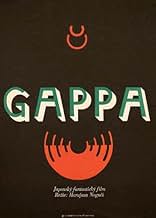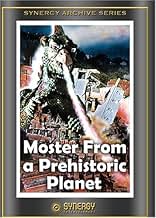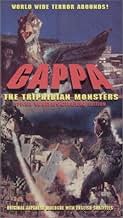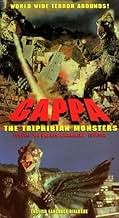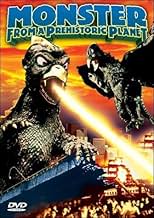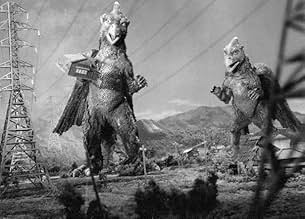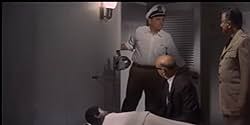CALIFICACIÓN DE IMDb
4.4/10
1.8 k
TU CALIFICACIÓN
Agrega una trama en tu idiomaMagazine reporters Hiroyuki Kurosaki and his colleagues brought back to Japan a monster child who had just hatched from an egg issued on the isolated island of Obelisk in the South Sea.Magazine reporters Hiroyuki Kurosaki and his colleagues brought back to Japan a monster child who had just hatched from an egg issued on the isolated island of Obelisk in the South Sea.Magazine reporters Hiroyuki Kurosaki and his colleagues brought back to Japan a monster child who had just hatched from an egg issued on the isolated island of Obelisk in the South Sea.
- Dirección
- Guionistas
- Elenco
Tamio Kawaji
- Hiroshi Kurosaki
- (as Tamio Kawachi)
Yûji Odaka
- Prof. Daize Tonooka
- (as Yuji Kodaka)
Yôko Ôyagi
- Aihara
- (as Yoko Oyagi)
Opiniones destacadas
A group of intrepid explorers is sent on an expedition to find exotic animals (and people) for a new theme park to be built by a magazine tycoon who also happens to publishes Playmate Magazine. Soon, the group lands on an island in the South Pacific, where they discover an isolated tribe of natives who worship a mysterious God named Gappa. When the land is ruptured by an earthquake, the explorers come upon a cavern containing a reptilian egg. They take it back to a Japanese research center, where the creature hatches and is studied by a group of not too bright scientists. Unfortunately, the parental Gappas show up to claim their newborn lizard, trashing most of Tokyo in the process.
I had a great time watching this piece of nonsense. Just about everything in this film is a complete riot. After a somewhat slow first half, the action is almost non-stop and there's plenty of stupendous dialog to keep you entertained. The production values consist mostly of hilariously cheap-looking scale models, the story and the acting are ridiculous and most of the characters are empty-headed idiots, especially for a group of scientists. The monster, Gappa, is a kind of bird-lizard, basically a ridiculous looking over-sized chicken. When it flies, it sounds like an airplane, but that's probably the result of a slip-up in the sound effects, because the creature gets attacked by fighter planes a couple of times.
Made by the Nikkatsu Studios to make a late cash-in on the success of Godzilla- and many other monster movies and - what I understand - it was also meant as a kind of satire on the monster movie craze. Well, that aspect of the film was a bit lost on me, or probably got lost in time or translation, but then, I'm hardly an expert on Japanese old-school kaiju-flicks.
Camera Obscura --- 6/10
I had a great time watching this piece of nonsense. Just about everything in this film is a complete riot. After a somewhat slow first half, the action is almost non-stop and there's plenty of stupendous dialog to keep you entertained. The production values consist mostly of hilariously cheap-looking scale models, the story and the acting are ridiculous and most of the characters are empty-headed idiots, especially for a group of scientists. The monster, Gappa, is a kind of bird-lizard, basically a ridiculous looking over-sized chicken. When it flies, it sounds like an airplane, but that's probably the result of a slip-up in the sound effects, because the creature gets attacked by fighter planes a couple of times.
Made by the Nikkatsu Studios to make a late cash-in on the success of Godzilla- and many other monster movies and - what I understand - it was also meant as a kind of satire on the monster movie craze. Well, that aspect of the film was a bit lost on me, or probably got lost in time or translation, but then, I'm hardly an expert on Japanese old-school kaiju-flicks.
Camera Obscura --- 6/10
I was visiting this movie approximately in 1972, when communist allow us to see two or three Japanese "sci-fi" movies. In that time it has been for me something new, I've been a small boy, but I feel it is not good. But it has been from my lovely sci-fi section and now I bought a DVD and look at it with pleasure. There is so much mistakes... For example the rocket propulsion of that giant lizards, the fire from their mouths when they destroyed all military technology - tanks and aircraft, their bullet, bomb and rocket proof skin. The monsters can fly, walk and float under see, just one problem they have - they don't like high-frequency sound, so army can thrust their from the lake under Fuji. On the island, where from are the monsters are living the natives which are waiting tens generations for Japanese liberators, but almost all know the Japanese language! The end is beautiful and very sentimental - first and last time you can see a giant monster to cry:-)
Move over Dr Strangelove; "Monster from a Prehistoric Planet" is the new satire in town. Okay, maybe my sarcasm is unjustified, Japanese satire is either too high brow for me or gets completely lost in translation. And its perfectly easy to loose anything in the atrocious dubbing kaiju films get plastered with.
If I'm kind I have to call it a parody of King Kong; as the film deals with an expedition force, who are trying to find exotic animals for a new theme park, stumbling across a mysterious island where the indigenous tribe (who look strangely similar to Japanese with coal on their faces) worship a god called Gappa. The expedition take a baby Gappa back to Japan, with the parents in hot pursuit. Cue the miniatures.
With the hideously handled love side story and the hilariously sentimental finale, I can only assume that this film was intended as tongue in cheek fare, and the satire label certainly confirms this. This aside however, the film is terrific by the standards of the time, with incredible amounts of destruction and very little time to breathe in between. Whether I'm missing the supposed hard-hitting social satire I don't really care; "Monster from a Prehistoric Planet" is a wonderfully extravagant example of monster films done properly, with a plot that doesn't dither amount and action that moves back to Japan pretty swiftly and doesn't let up from then on. The clichés are all over the place but this is hardly an issue, intentional or otherwise. Certainly, a kaiju film trying its hand at satire would be expected to be about as subtle as a ton of bricks, and with this in mind the film could have turned out a hell of a lot worse.
(To the elite, "Monster from a Prehistoric Planet" has a special appeal. The Gappas are the very same monsters that menaced Kryten and Rimmer on wax world in series 4 of Red Dwarf; and as Kryten observed, you've probably seen more convincing dinosaurs in a packet of "wheatie flakes")
If I'm kind I have to call it a parody of King Kong; as the film deals with an expedition force, who are trying to find exotic animals for a new theme park, stumbling across a mysterious island where the indigenous tribe (who look strangely similar to Japanese with coal on their faces) worship a god called Gappa. The expedition take a baby Gappa back to Japan, with the parents in hot pursuit. Cue the miniatures.
With the hideously handled love side story and the hilariously sentimental finale, I can only assume that this film was intended as tongue in cheek fare, and the satire label certainly confirms this. This aside however, the film is terrific by the standards of the time, with incredible amounts of destruction and very little time to breathe in between. Whether I'm missing the supposed hard-hitting social satire I don't really care; "Monster from a Prehistoric Planet" is a wonderfully extravagant example of monster films done properly, with a plot that doesn't dither amount and action that moves back to Japan pretty swiftly and doesn't let up from then on. The clichés are all over the place but this is hardly an issue, intentional or otherwise. Certainly, a kaiju film trying its hand at satire would be expected to be about as subtle as a ton of bricks, and with this in mind the film could have turned out a hell of a lot worse.
(To the elite, "Monster from a Prehistoric Planet" has a special appeal. The Gappas are the very same monsters that menaced Kryten and Rimmer on wax world in series 4 of Red Dwarf; and as Kryten observed, you've probably seen more convincing dinosaurs in a packet of "wheatie flakes")
If the plot seems a bit derivative, it was meant to. This was Nikkatsu studios first and only monster flick. It was produced strictly to cash-in at the height of the genre. The writers knew it had all been done before, so they took those cliches, and satirized them. Like the greedy entrepreneur, responsible for drawing the monster's parents to look for their baby. I like the extra touches, like the mother carrying an octopus in her mouth, (while stomping buildings) to feed her young. The effect scenes were shot at Eiji Tsuburaya's newly formed independent studio, which was producing the first UltraMan series at the time. Surprisingly, this film holds up very well, passing the test of time. Besides, these monsters show up only in one film. How many kaiju can you say that about ? This is also one of the few Japanese movies commercially available on video, widescreen and subtitled. Two appendages up !!!
Nikkatsu Studio was one of the six largest movie studio in Japan at the time this movie was made, but due to the proliferation of TV sets, Japanese movie industry was in a steady economic decline. Kaijyu or giant monster movies were about the only franchise that were still making good money, and Nikkatsu made an attempt to jump in to this genre with this movie.
A Japanese expedition to the south pacific island unwittingly stumble onto a newly hatched baby triphibian reptile which the natives call "Gappa", and brings it back to Japan. A greedy publishing magnate, and an amusement park promoter notices a good thing when he sees one and decides to display the baby at his park. This didn't sit well with the parents of the baby reptile, and they show up in Japan to claim their kid. Rest is stereotypical giant monster mayhem.
This movie as far as I know is the only movie that features a complete family of giant monsters or "Kaijyu" ever to be shown together. It's also a first Triphibian monster that can walk, breathe underwater, and fly. The story is bit derivative where I can see little pieces off of Gorgo, Mothra, Godzilla, King Kong etc. and not very original, but the special effects in this movie is surprisingly good for a studio's first attempt. Gappa is not just an mindless monster, but actually seems to have intelligence behind their actions. This lowers the tension of the monster's character as an engine of destruction, and the movie carries on with bit of a bore, but the overall production is good, and ranks as an average giant monster movie. You get to see a very young Yoko Yamamoto playing the star in this movie. She's still acting after nearly 50 years since this movie was made, and amazingly, still beautiful in her roles.
A Japanese expedition to the south pacific island unwittingly stumble onto a newly hatched baby triphibian reptile which the natives call "Gappa", and brings it back to Japan. A greedy publishing magnate, and an amusement park promoter notices a good thing when he sees one and decides to display the baby at his park. This didn't sit well with the parents of the baby reptile, and they show up in Japan to claim their kid. Rest is stereotypical giant monster mayhem.
This movie as far as I know is the only movie that features a complete family of giant monsters or "Kaijyu" ever to be shown together. It's also a first Triphibian monster that can walk, breathe underwater, and fly. The story is bit derivative where I can see little pieces off of Gorgo, Mothra, Godzilla, King Kong etc. and not very original, but the special effects in this movie is surprisingly good for a studio's first attempt. Gappa is not just an mindless monster, but actually seems to have intelligence behind their actions. This lowers the tension of the monster's character as an engine of destruction, and the movie carries on with bit of a bore, but the overall production is good, and ranks as an average giant monster movie. You get to see a very young Yoko Yamamoto playing the star in this movie. She's still acting after nearly 50 years since this movie was made, and amazingly, still beautiful in her roles.
¿Sabías que…?
- TriviaThe main and end title music heard in the overseas releases of this film (for example, Monster from a Prehistoric Planet in the U.S.) were from an earlier film also scored by Seitaro Omori, the Nikkatsu teen drama/comedy film Youth Song (1959).
- ErroresAt 54:00 when airplanes attack the Gappas, for a brief moment during a view from an airplane target one can see where the fake sky backdrop ends and the movie studio beyond it.
- Citas
President Funazu: Like it? I call it Playmate Land.
- Versiones alternativasIn all English-dubbed versions of the film, the rock and roll theme song titled "Great Giant Beast Gappa" (heard in both the opening credits and the ending of the original Japanese version of it) is replaced by standard orchestral music. Also, the Japanese version features a song titled "Keep Trying, Baby Gappa!" (heard in the scene at the end of the film where the male and female Gappas are reunited with their baby). In all English-dubbed versions, the song's vocals are cut and thus, it becomes an instrumental song.
- ConexionesEdited into Red Dwarf: Meltdown (1991)
- Bandas sonorasDaikyojû Gappa
("Great Giant Beast Gappa")
Opening and Ending Theme (Japanese version only)
Music by Masao Yoneyama
Arrangement by Iwao Shigematsu
Lyrics by Hikari Ichijô
Performed by Katsuhiko Miki
Selecciones populares
Inicia sesión para calificar y agrega a la lista de videos para obtener recomendaciones personalizadas
- How long is Gappa the Triphibian Monster?Con tecnología de Alexa
Detalles
- Fecha de lanzamiento
- País de origen
- Idioma
- También se conoce como
- Gappa the Triphibian Monster
- Productoras
- Ver más créditos de la compañía en IMDbPro
- Tiempo de ejecución1 hora 30 minutos
- Mezcla de sonido
- Relación de aspecto
- 2.35 : 1
Contribuir a esta página
Sugiere una edición o agrega el contenido que falta

Principales brechas de datos
By what name was Gappa, los monstruos del Pacífico (1967) officially released in India in English?
Responda

